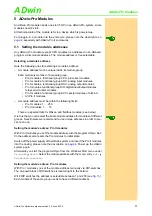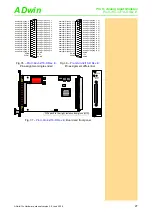
ADwin-Pro
Hardware, manual version 2.9, June 2006
13
Processor modules
ADwin
5.2 Processor modules
For each
ADwin-Pro
system one processor module is required. This processor
module is the center of a Pro system and performs the following tasks:
– Communication with PC or laptop.
The data connection is established via USB or Ethernet; former version
used a serial link connection.
– Communication with other
ADwin-Pro
modules via internal Pro bus.
– Srarting and runing the user defined processes.
The processor module provides the memory for data and programs, divided
into a fast internal memory (SRAM) and an external memory (DRAM).
Overview CPU modules
The processor modules differ mainly in computing power (clock rate):
Input Event In
The external trigger input (
Event
In
) enables the processor module to recog-
nize an external signal as trigger for an event and trigger a process, that is pro-
cessed immediately and completely (see
ADbasic
manual, chapter: Structure
of the
ADbasic
program).
The event signal has to be present for 50ns to be recognized (specified value
for CPU-T9 in basic version; 25ns are typical).
Alternatively, the event input of an other module may be used. All event signals
arrive at the same signal line of the processor module as the input
Event
In
does.
Module
System
Pro I
Pro I
Pro I
Processor
ADSP 21062
ADSP 21062
ADSP 21162
Clock rate
40MHz
40MHz
80MHz
Data connection
Link
Ethernet, USB Ethernet, USB
Internal
memory
256kB
opt. 512kB
256kB
opt. 512kB
512kB
External
memory
4MB
opt. 16 / 32MB
16MB
opt. 64MB
128MB
Inputs
Event In
Event In
opt. Digin 0
Event In
Digin 0
Module
System
Pro II
Processor
ADSP
TS101S
Clock rate
300MHz
Data connection
Ethernet
Internal
memory
768kB
External
memory
256MB
Inputs
Event In
DigIO 0,
DigIO 1
Fig. 15 – Overview Pro CPU modules
















































